by Adam Baldwin
[email protected]
Special to L. Neil Smith’s The Libertarian Enterprise
“Know the enemy and know yourself: in a hundred battles you will never be in peril.
When you are ignorant of the enemy but know yourself, your chances of winning or losing are equal.;
If ignorant both of your enemy and of yourself, you are certain in every battle to be in peril.”
— Sun Tzu, The Art of War
In Part 1 we looked at the four factions that make up the Democratic party coalition in America according to Pew Research. In Part 2 we will look at the four factions that make up the Republican Party coalition as argued by Pew Research. Once again my commentary is in (brackets) and my liberal use of quotations the Pew Research report is in quotation marks and is italicized.
Below for those interested in further investigation is a link to the Pew Research report:
https://www.pewresearch.org/politics/2021/11/09/beyond-red-vs-blue-the-political-typology-2/
For those interested in Part 1 of this synopsis and my commentary of Pew Research‘s report you can find it linked below:
https://ncc-1776.org/tle2022/tle1148-20220320-04.html
Pew Research has placed all Americans into one of 9 factions within the two-party system. The graph below is gist of Pew Researches conclusions:
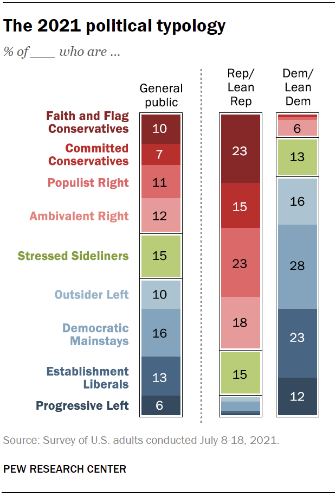
Pew Research argued in their report that a horseshoe image would accurately demonstrate the 9 political factions they believe exist in America today, yet did not provide such an image in their report. The image below is one I made based upon their conclusions.
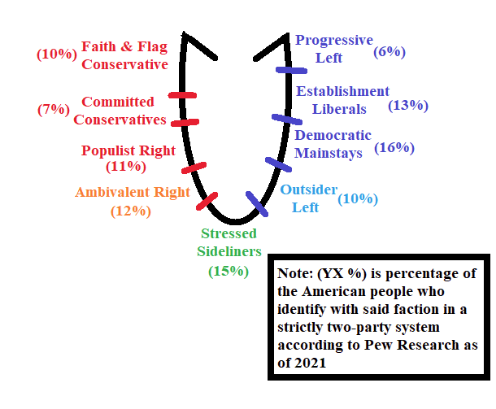
The Republican Coalition is united in a general consensus in small government, that currently the government does too much, a belief that individuals are responsible for their own success, and a rejection of white privilege. Beyond these general principles there is very little Republicans share consensus on.
The Republican Coalition argued by Pew Research is composed of: Faith & Flag Conservatives, Committed Conservatives, Populist Right, and Ambivalent Right
But what does this mean?
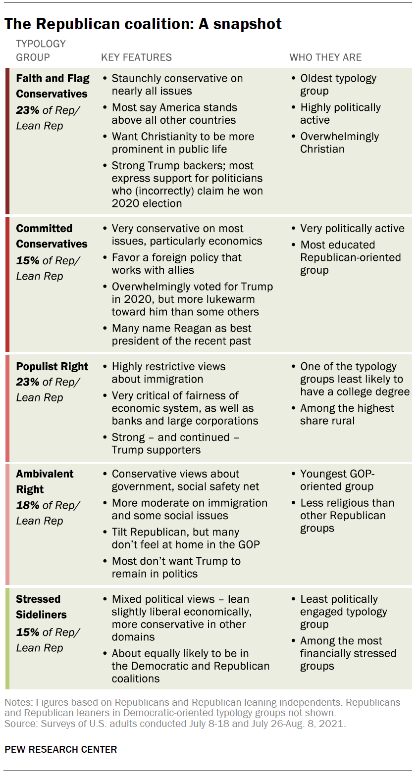
5. Faith and Flag Conservatives who they are:
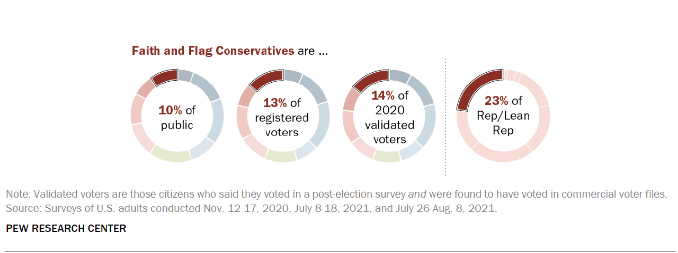
“Faith and Flag Conservatives are highly religious, politically engaged and both socially and economically conservative. They favor a robust role for religion in public life and a smaller role for government in society, and they hold that a strong American military is essential in international affairs. They overwhelmingly identify with the GOP and remain strong supporters of former President Donald Trump.
More than four-in-ten are White evangelical Protestants, the highest share of any political typology group. Faith and Flag Conservatives are more likely than those in other groups to emphasize the importance of religion in their lives and to hold restrictive attitudes on abortion and same-sex marriage; they are the sole group in which a majority (67%) say same-sex marriage being legal is bad for the country. They are also the only group in which a majority (58%) favors allowing public school teachers to lead students in Christian prayers.
Three-quarters of Faith and Flag Conservatives say that the best way to ensure peace is through military strength rather than through diplomatic means, by far the highest share of any group saying this. They are one of only two groups, alongside Populist Right, in which a majority favor increasing the size of America’s military.”
From Pew Research Report: Beyond Red vs. Blue: The Political Typology, Nov 9, 2021
(Faith and Flag Conservatives as a group advocate for smaller government and lower taxes and yet favor a strong military. Faith and Flag Conservatives as a group even favor the Federal government using violence over diplomacy to settle disputes with foriegn nations if Pew‘s research is to be believed. Historically, warfare is the number one cause of the rapid expansion of the size and authority of government and the governments need to raise taxes. Faith and Flag Conservatives are either confused about what they want or are total hypocrites. America can have a small government and low taxation or a warfare-state and high taxation it can never be both. )
“About three-quarters (77%) say that cities and towns should be allowed to place religious symbols on public property. A similar share (75%) say government policies should support religious values (the only typology group in which a majority says this). And 83% say the decline in the share of Americans belonging to an organized religion is bad for society.”
From Pew Research Report: Beyond Red vs. Blue: The Political Typology, Nov 9, 2021
“Nearly four-in-ten Faith and Flag Conservatives (38%) said they definitely or probably would not get a COVID-19 vaccine as of late August, similar to the 39% of Populist Right who said this”
From Pew Research Report: Beyond Red vs. Blue: The Political Typology, Nov 9, 202
“And they are highly skeptical of political compromise: 53% of Faith and Flag Conservatives say that “compromise is really just selling out on what you believe in.”
From Pew Research Report: Beyond Red vs. Blue: The Political Typology, Nov 9, 202
“Faith and Flag Conservatives are the oldest typology group, with a median age of 57”
From Pew Research Report: Beyond Red vs. Blue: The Political Typology, Nov 9, 202
“Along with Committed Conservatives and Populist Right, they have the highest share who identify as non-Hispanic White (85%). Nearly six-in-ten (58%) are men, the highest share in the typology – along with Committed Conservatives. They are also among the most likely to live in rural communities.”
From Pew Research Report: Beyond Red vs. Blue: The Political Typology, Nov 9, 202
“Faith and Flag Conservatives are one of the two most politically engaged groups, alongside Progressive Left. They voted at very high rates in 2020 – 85% of those eligible to vote did so – and in the months leading up to the 2020 election, a higher share (31%) contributed money to a candidate for office or to a group working to elect a candidate than in any other Republican-oriented group.”
From Pew Research Report: Beyond Red vs. Blue: The Political Typology, Nov 9, 202
(What I find most surprising about Faith and Flag Conservatives is the diversity within their ranks. Faith and Flag Conservatives undoubtedly make up the majority of the membership of the Constitutional Law Party besides the Republican party. Leading conservative intellectuals such as Pat Buchanan and Chuck Baldwin probably best fit in the Faith and Flag Conservative faction according to Pew Research and yet have little in common with the mainstream evangelical movement. I also find it very interesting that the extremes in America appear to be Progressive Liberals Vs. Faith and Flag Conservatives and yet it is clear that Progressive Liberals and Populist Right are the ones wishing for a political revolution in this country. Faith and Flag Conservatives as a whole for all their chest thumping and anger that the 2020 election was stolen from President Trump are in actual fact; prosperous, fat, and content with the status quo.)
6. Committed Conservatives who they are:

“Staunchly conservative and overwhelmingly Republican, Committed Conservatives hold pro-business views traditionally associated with the Republican Party, have favorable attitudes about international trade and favor a limited role of government. Their approach to international relations centers on engaging with U.S. allies and maintaining American military might.
Committed Conservatives tend to hold more moderate positions on immigration than the two other deeply conservative groups in the Republican coalition – Faith and Flag Conservatives and Populist Right. They also are slightly more moderate than these groups on some issues related to racial and ethnic equality but still more conservative than the Democratic-oriented groups.”
From Pew Research Report: Beyond Red vs. Blue: The Political Typology, Nov 9, 202
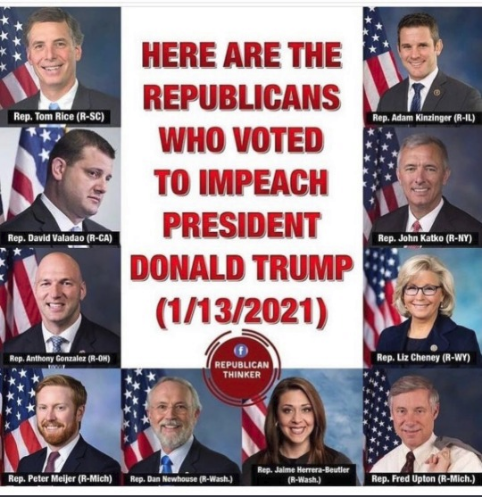
Committed Conservatives anyone?
“Along with Faith and Flag Conservatives, Committed Conservatives have the highest share of any group to say that everyone has it in their own power to succeed, and nearly eight-in-ten (78%) say government aid to the poor does more harm than good.”
From Pew Research Report: Beyond Red vs. Blue: The Political Typology, Nov 9, 202
“Two-thirds say the statement “vaccines are the best way to protect Americans from COVID-19” describes their views very or somewhat well, a higher share than in any of the other Republican-oriented groups, including the Ambivalent Right.”
From Pew Research Report: Beyond Red vs. Blue: The Political Typology, Nov 9, 202
(This validates my argument that Committed Conservatives are as a group mostly Statists and have more in common with Establishment Liberals than any of the other factions that make up the Republican Party coalition. Committed Conservatives are committed to Capitalism and them personally benefiting from it; otherwise they basically are Establishment Liberals in their political outlook.)
“About eight-in-ten Committed Conservatives (82%) are White and one-in-ten are Hispanic; far smaller shares are Asian (3%) or Black (1%). Nearly six-in-ten (58%) are men and most (56%) are ages 50 and older, including 31% who are at least 65 years old.
Committed Conservatives are among the most educated of the GOP-oriented groups and are among the highest-income political typology groups. A quarter live in upper-income households, similar to Faith and Flag Conservatives and Establishment Liberals but a higher share than in most other groups.
(Once again see Commited Conservatives attended the same progressive/statist universities and colleges and have similar tastes in consumer goods, food, and pop culture as their Establishment Liberal alter egos. )
Nearly seven-in-ten Committed Conservatives (69%) rate their personal financial situation as either excellent or good, compared with half of all U.S. adults. An identical share say they have an IRA, 401(k) or similar type of retirement account, making them the typology group most likely to have this type of account. And 53% say they have personal investments in stocks, bonds or mutual funds in addition to their retirement accounts.
Nearly two-thirds of Committed Conservatives (65%) say they had received all of the necessary shots to be fully vaccinated against COVID-19 as of late August, a smaller share than among any of the four Democratic-oriented groups but a larger share than among Faith and Flag Conservatives or Populist Right (51% each).”
From Pew Research Report: Beyond Red vs. Blue: The Political Typology, Nov 9, 202

Another Committed Conservative Anyone?
7. Populist Right who they are:
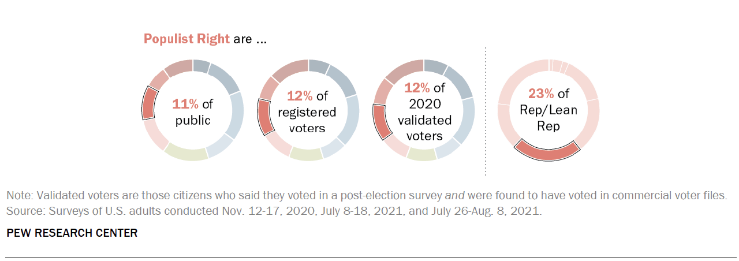
“Very conservative and overwhelmingly Republican, Populist Right hold highly restrictive views about immigration policy and are very critical of government. But, in contrast to other parts of the GOP coalition, their criticism extends well beyond government to views of big business and to the economic system as a whole: 82% say that large corporations are having a negative impact on the way things are going in the country, and nearly half support higher taxes on the wealthy and on large corporations.
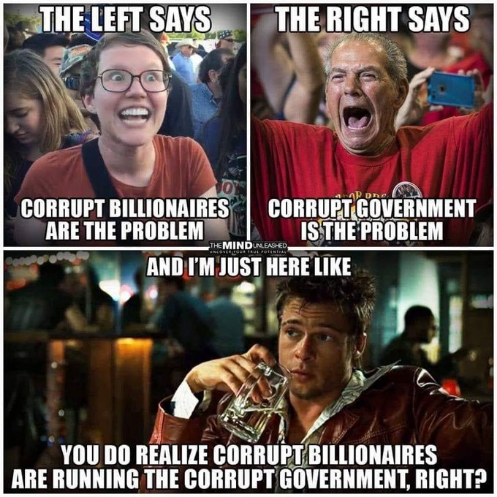
Like the other two deeply ideologically conservative typology groups, Populist Right are overwhelmingly White (85%). However, in contrast to these groups, a majority of Populist Right are women (54%). Populist Right are also one of the least highly educated groups; just two-in-ten are college graduates.”
From Pew Research Report: Beyond Red vs. Blue: The Political Typology, Nov 9, 202
(Notice the class bias of the authors of this Pew Research report, because the Populist Right has the fewest college degrees of any othe the nine factions, as stated by Pew Research, populists must be a bunch of ignorant inbred rednecks. I was shocked to find out that if you identify as Populist Right you are more likely to be a woman than a man.)
“But they stand out from the rest of the Republican coalition in their views about the economic system. Nearly nine-in-ten (87%) say that the economic system in this country unfairly favors powerful interests, far higher than the share in any other Republican-oriented group and more in line with groups in the Democratic coalition on this question.
A majority of Populist Right (56%) say that taxes on household income over $400,000 should be raised and that taxes on large businesses and corporations should be raised (also 56%). Fewer than half of Faith and Flag Conservatives, Committed Conservatives or the Ambivalent Right favor these tax proposals.”
From Pew Research Report: Beyond Red vs. Blue: The Political Typology, Nov 9, 202
“Like other Republican-oriented groups, Populist Right generally say that the entertainment industry, technology companies and labor unions are having a negative effect on the way things are going in the country today. They are also more likely to say this about both colleges and universities and K-12 public schools than any other group aside from Faith and Flag Conservatives.
However, unlike the other Republican-oriented groups, Populist Right also say that large corporations (82%) and financial institutions (60%) are having a negative impact. Progressive Left are the only group more critical of these institutions.”
From Pew Research Report: Beyond Red vs. Blue: The Political Typology, Nov 9, 202
“Populist Right are—along with Faith and Flag Conservatives—more likely than those in other groups to live in rural areas (38% of Populist Right, 39% of Faith and Flag Conservatives). They are one of the typology groups with the lowest share of college graduates: Just under half (45%) have a high school diploma or less education, while 34% have some college education but not a four-year degree.
(“Allegiance and socialization, however, are intrinsic to the role of schooling in our society or any hierarchical society. Socialist leaders such as Fidel Castro and Mao Tse-tung vastly extended schooling in Cuba and China in part because they knew that an educated people is a socialized populace and a bulwark of allegiance. Education works the same way here: it encourages students not to think about society but merely to trust that it is good.”
—James W. Loewen, author of the Book, Lies My Teacher Told Me, paperback page 351
In other words, educated people are no smarter than uneducated people and those without college degrees from the leftist/statist madrassas called higher education are in fact more likely to critically question the system. Being more likely to live in a rural environment than other factions, leads to the Populist Right to be more independent in general.)
About half of Populist Right (52%) say that their personal finances are in only fair or poor shape, similar to the share of all U.S. adults (48%) saying this. Their average income level is similar to the public’s overall, though they are somewhat more likely than average to live in middle-income households (53% do so, compared with 47% of the public overall).
Roughly half of the Populist Right (53%) are Protestants, a higher share than any group besides Faith and Flag Conservatives, and 27% are White evangelical Protestants.”
From Pew Research Report: Beyond Red vs. Blue: The Political Typology, Nov 9, 202
(The Populist Right being predominantly rural working class people have taken the brunt of the negative economic effects of decades of Federal Reserve policies that favor the FIRE sector over the rest of the economy, coupled with the destructive effects of free trade agreements such as NAFTA, the offshoring of our manufacturing base, and environmental regulations that have limited logging, fishing, mining, and manufacturing. The Populist Right has figured out that the whole system has been corrupted and is being used against the people and they are ready for revolution. Both the Progressive Left and the Populist Right want revolution, but both have radically different views of the nature of that revolution. The Progressive Left wants effectively Communism and the Populist Right wants a return to smaller government/taxation and a return to 1950‘s-1960‘s economic prosperity for all. The Populist Right is as ideologically opposed to the Progressive left as the Faith and Flag Conservative.)
8. Ambivalent Right who are they:
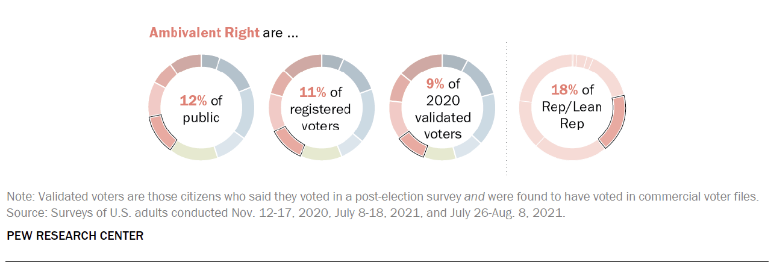
On core issues related to the size and role of government, Ambivalent Right hold views that are traditionally associated with the GOP: Most (63%) say that government regulation of business usually does more harm than good, and nearly three-quarters (73%) prefer a smaller government providing fewer services to a bigger government providing more services.
Just over half (54%) say abortion should be legal in all or most cases, a view held by far smaller shares of those in other GOP groups. And six-in-ten Ambivalent Right say that marijuana should be legal for both recreational and medical use by adults—identical to the share of the overall public saying this, but a view not held by most of those in other GOP-oriented groups. Ambivalent Right also are as likely to say that same-sex marriage being legal is good for society (28%) as to say that it is bad for society (29%); 43% say it is neither good nor bad. In each of the other Republican-oriented groups, more say legal same-sex marriage is bad for society than say it is good.
Three-quarters say that America’s openness to people from all over the world is “essential to who we are as a nation,” compared with no more than a third of those in other Republican-oriented groups. They are also substantially more likely than those in other GOP groups to say that good diplomacy, rather than military strength, is the best way to ensure peace.
And most (63%) would not like to see Trump continue to be a major national political figure for many years to come.
With 63% of Ambivalent Right adults under the age of 50, they are substantially younger than other Republican-oriented groups. About two-thirds (65%) are White, 17% are Hispanic, 8% are Black and 5% are Asian, making this group more racially and ethnically diverse than other GOP coalition groups.
Ambivalent Right are younger and more racially and ethnically diverse than other Republican-oriented groups. They are also somewhat less religiously affiliated: 27% are religiously unaffiliated, compared with 20% of Populist Right, 18% of Committed Conservatives and just 6% of Faith and Flag Conservatives.
Ambivalent Right are a GOP-leaning group as a whole—68% identify as or lean Republican—and they make up a substantial share of all Republicans and GOP leaners (18%). But this group also includes a significant number of Democrats: A quarter of Ambivalent Right either identify with or lean toward the Democratic Party, and a similar share (25%) voted for Joe Biden in the 2020 presidential election.
They are similar to the general population on both household income and education: 28% live in lower-income households (compared with 31% of all U.S. adults), 48% live in middle-income households (vs. 47% of all adults) and 19% live in upper-income households (vs. 17% of all adults). About a third (35%) have a college degree, roughly the same share as among the adult population overall (32%).”
From Pew Research Report: Beyond Red vs. Blue: The Political Typology, Nov 9, 202
(Pew Research‘s Ambivalent Right appears to be made up of politically uncertain young people who lean conservative and Libertarians. I openly question whether libertarians are even of the Right?)

In Part 3 we will look at Stressed sideliners and discuss what can be concluded from Pew Researches informative report.

Yours in Liberty,
Adam Baldwin
Was that worth reading?
Then why not:
